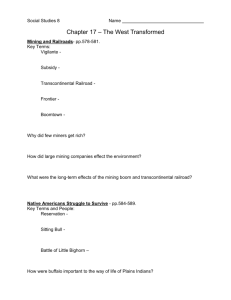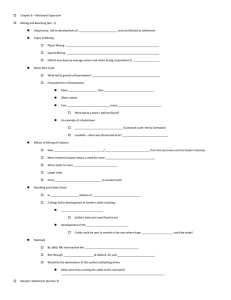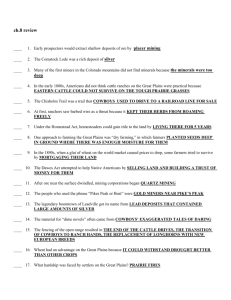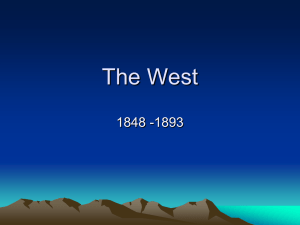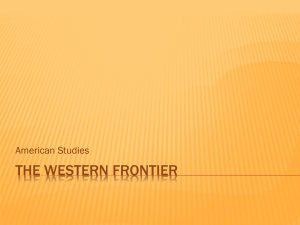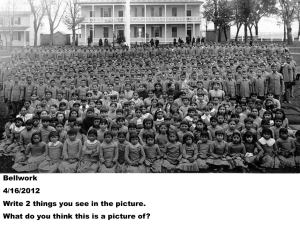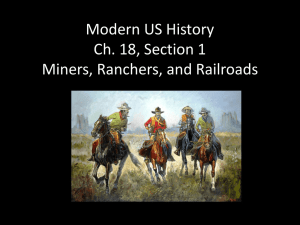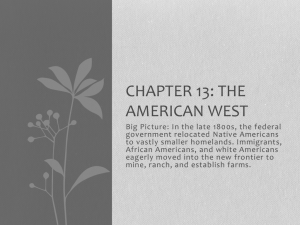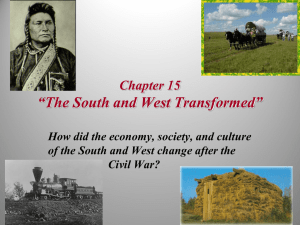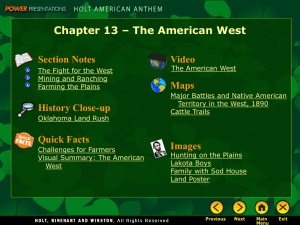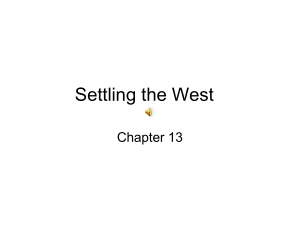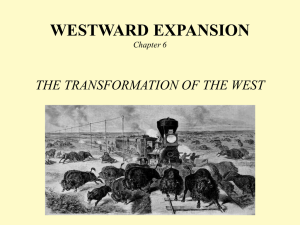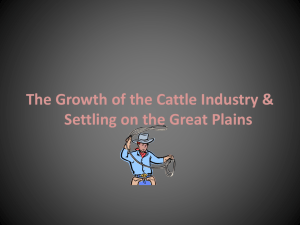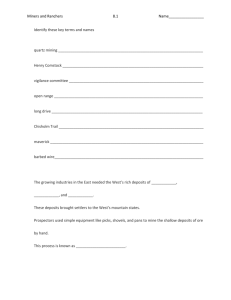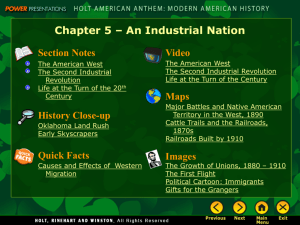Chapter 11, Section 3 Guided Notes Miners Hope to Strike it Rich
advertisement
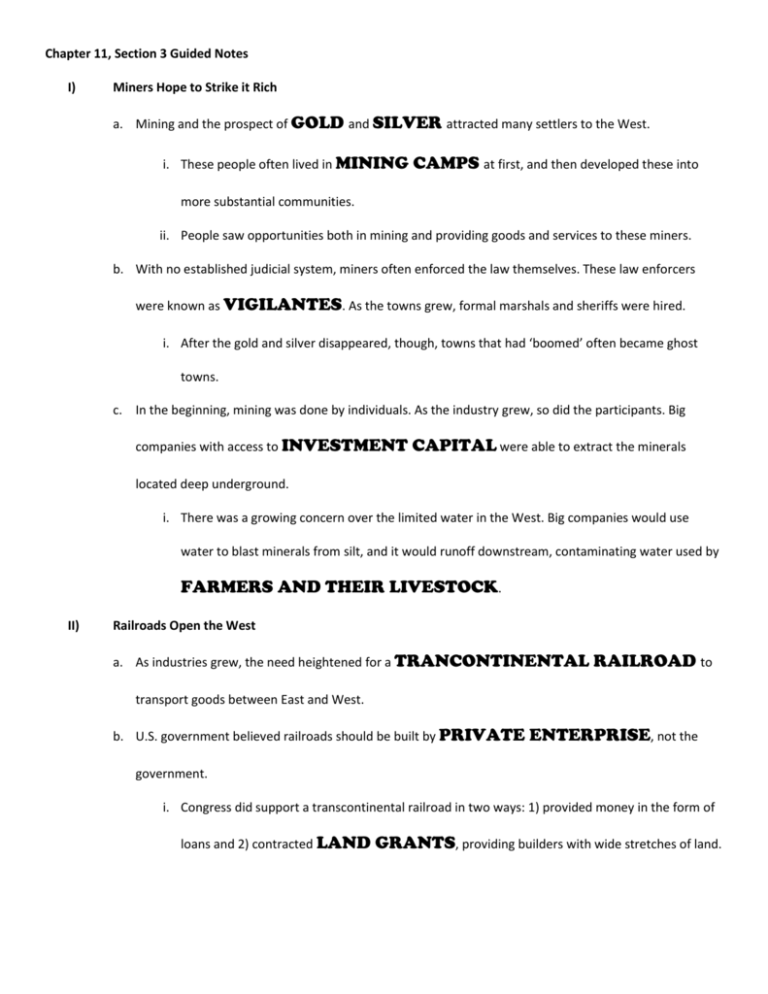
Chapter 11, Section 3 Guided Notes I) Miners Hope to Strike it Rich a. Mining and the prospect of GOLD and SILVER attracted many settlers to the West. i. These people often lived in MINING CAMPS at first, and then developed these into more substantial communities. ii. People saw opportunities both in mining and providing goods and services to these miners. b. With no established judicial system, miners often enforced the law themselves. These law enforcers were known as VIGILANTES. As the towns grew, formal marshals and sheriffs were hired. i. After the gold and silver disappeared, though, towns that had ‘boomed’ often became ghost towns. c. In the beginning, mining was done by individuals. As the industry grew, so did the participants. Big companies with access to INVESTMENT CAPITAL were able to extract the minerals located deep underground. i. There was a growing concern over the limited water in the West. Big companies would use water to blast minerals from silt, and it would runoff downstream, contaminating water used by FARMERS AND THEIR LIVESTOCK. II) Railroads Open the West a. As industries grew, the need heightened for a TRANCONTINENTAL RAILROAD to transport goods between East and West. b. U.S. government believed railroads should be built by PRIVATE ENTERPRISE, not the government. i. Congress did support a transcontinental railroad in two ways: 1) provided money in the form of loans and 2) contracted LAND GRANTS, providing builders with wide stretches of land. c. The Central Pacific and Union Pacific rail lines started in opposite directions and built towards one another. It was not easy: there was a shortage in labor, so Chinese immigrants were brought over and treated harshly. i. In 1869 in PROMONTORY SUMMIT, Utah, the two rail lines met. d. The West experienced a population boom with simply the prospect of a railroad being built. White settlers invaded both Native American and Mexican American lands. i. From 1864 to 1896, the Union gained 10 new states, each with a population of at least 60,000 people. III) Ranchers Build the Cattle Kingdom a. CATTLE RANCHING also boomed in the West. Before white settlers, Mexicans had employed an OPEN-RANGE policy for their cattle, in which they roamed freely within a given boundary and were identified by a brand or mark by their owner. i. Cattle were rounded up in the spring and cowboys drove the cattle to the nearest junction on the railroad to transport them east. b. Several factors contributed to the end of open-range cattle farming, which had flourished after the Civil War. These included: i. INVENTION OF BARBED WIRE; ii. Price of beef dropped; iii. Extreme weather dried up springs and the cattle’s food source. Farmers began to grow hay to feed livestock. IV) Farmers Settle on Homesteads a. Great Plains were previously set aside for Native Americans because the land was viewed as NOT FIT FOR AGRICULTURE. b. Settlers came to the Plains sporadically, being attracted by lands for sale, such as with the HOMESTEAD ACT of 1862. i. The goal of the government was to attract settlers by promising 160 ACRES of land in exchange for digging a well or building a road. ii. Some of these settlers were African Americans, known as EXODUSTERS. 1. These individuals migrated to Kansas and Oklahoma. c. The harsh conditions of the Plains coupled with a lack of invention made it difficult to build homes and maintain agriculture. V) Competition, Conflict and Change a. The array of settlers on the Plains caused conflict over how the land should be used. Mining, cattle ranching and farming all conflicted in various ways, competing over water as well as land. b. The West’s population was highly DIVERSE. i. Cultural differences lead to discrimination. The frontier was now populated by Mexicans, Native Americans, and even IMMIGRANTS, such as the Chinese. c. The ‘frontier’ slowly dwindled until every square mile of the United States was populated by some settlers in 1890. i. The last rush for land occurred in OKLAHOMA in 1889. d. The increased population from diverse cultures foreshadowed more conflict that was to come on the frontier. Concept Questions: 1) What were the two major phases of mining? INDIVIDUAL MINERS WORKED ON THE SURFACE WHILE BIG MINING COMPANIES CONTROLLED DEEP UNDERGROUND MINING. 2) How did the government encourage the development of the transcontinental railroad? IT PROVIDED THE MONEY FOR CONSTRUCTION AND GAVE LAND GRANTS TO RAILROAD COMPANIES. 3) How did the railroad affect the cattle industry? EASIER WAY TO SHIP BEEF TO MARKET; THE JOB OF RANCHERS AND COWHANDS WAS TO GET THE CATTLE TO MARKET. 4) Why did farmers move to the Plains? TO OWN LAND AND FOR MORE SPACE, FREEDOM OR PROFIT. 5) What were some of the causes of prejudice and discrimination in the West? 80% OF THE NATION’S MINORITY GROUPS LIVED IN THE WEST. DIFFERENCES IN LANGUAGE, FOOD, RELIGION, ETC. INCREASED DISTRUST BETWEEN THE GROUPS.
